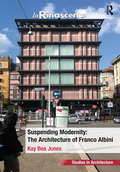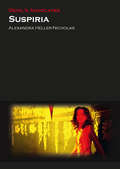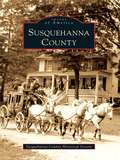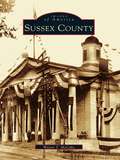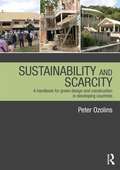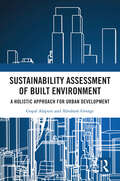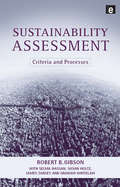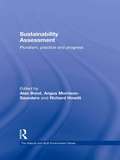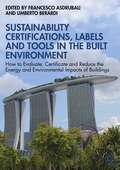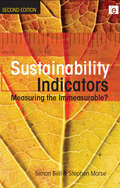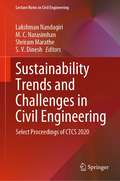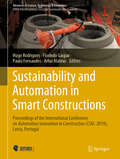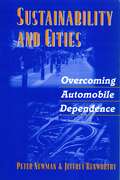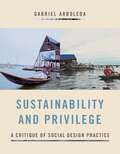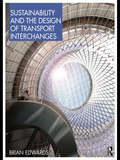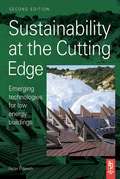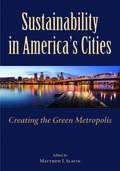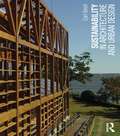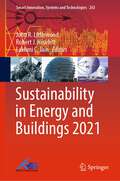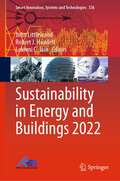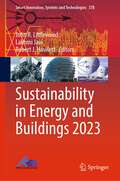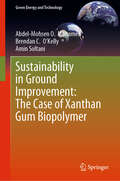- Table View
- List View
Suspending Modernity: The Architecture Of Franco Albini (Ashgate Studies In Architecture Ser.)
by Kay Bea JonesFranco Albini’s works of architecture and design, produced between 1930 and 1977, have enjoyed a recent revival but to date have received only sporadic scholarly attention from historians and critics of the Modern Movement. A chorus of Italian voices has sung his praises, none more eloquently than his protégé, Renzo Piano. Kay Bea Jones’ illuminating study of selected works by Studio Albini will reintroduce his contributions to one of the most productive periods in Italian design. Albini emerged from the ideology of Rationalism to produce some of Italy’s most coherent and poetic examples of modern design. He collaborated for over 25 years with Franca Helg and at a time when professional male-female partnerships were virtually unknown. His museums and installation motifs changed the way Italians displayed historic artifacts. He composed novel suspension structures for dwellings, shops, galleries and his signature INA pavilions where levity and gravity became symbolic devices for connoting his subjects. Albini clarified the vital role of tradition in modern architecture as he experimented with domestic space. His cohort defied CIAM ideologies to re-socialize postwar housing and speculate on ways of reviving Italian cities. He explored new fabrication technologies, from the scale of furniture to wide-span steel structures, yet he never abandoned the rigors of craft and detail in favor of mass-production. Suspending Modernity follows the evolution of Albini’s most important buildings and projects, even as they reveal his apprehensive attitudes about the modern condition. Jones argues here that Albini’s masterful use of materials and architectural expression mark an epic paradigm shift in the modern period.
Suspense: Twenty Years of Thrills and Chills
by Martin GramsThe entire history of one of the greatest horror/mystery programs ever broadcast on radio and television.
Suspiria (Devil's Advocates)
by Alexandra Heller-NicholasAs one of the most globally recognisable instances of 20th century Eurohorror, Dario Argento’s Suspiria (1976) is poetic, chaotic, and intriguing. The cult reputation of Argento’s baroque nightmare is reflected in the critical praise it continues to receive almost 40 years after its original release, and it appears regularly on lists of the greatest horror films ever. For fans and critics alike, Suspiria is as mesmerising as it is impenetrable: the impact of Argento’s notorious disinterest in matters of plot and characterisation combines with Suspiria’s aggressive stylistic hyperactivity to render it a movie that needs to be experienced through the body as much as through emotion or the intellect. For its many fans, Suspiria is synonymous with European horror more broadly, and Argento himself is by far the most famous of all the Italian horror directors. If there was any doubt of his status as one of the great horror auteurs, Argento’s international reputation was solidified well beyond the realms of cult fandom in the 1990s with retrospectives at both the American Museum of the Moving Image and the British Film Institute. This book considers the complex ways that Argento weaves together light, sound and cinema history to construct one of the most breathtaking horror movies of all time, a film as fascinating as it is ultimately unfathomable.
Susquehanna County (Images of America)
by Susquehanna County Historical SocietyThe wild land of Susquehanna County, traversed but not inhabited by the Lenape tribe, was first settled after the Revolutionary War, mostly by veterans in search of affordable land and willing to pioneer. Their families built homes, churches, and businesses and formed thriving agricultural communities, taking advantage of natural resources like timber and bluestone. Rolling hills, clear lakes, and mountain streams form a scenic and peaceful backdrop, attractive to visitors. From the mountaintops, small communities can be seen in the valleys, their white church spires rising above the trees. Influenced by emigrants from New England, the larger towns replicate the neat white houses and shady tree-lined streets of the Northeast.
Sussex County
by Wayne T. MccabeIn 2003, Sussex County celebrates the two hundred fiftieth anniversary of its creation, which took place on June 8, 1753. At that time, all of present-day Sussex and Warren Counties were set aside from Morris County. Warren County was established by the state legislature in 1824, forming the current boundaries of Sussex County. Among the previously unpublished photographs in this history are views of the county's commercial and residential streets, mining and industrial facilities, and business establishments. The vast majority of the unique vintage images included here are drawn from Wayne T. McCabe's extraordinary collection of more than fifteen thousand photographs, glass negatives, postcards, and stereoscopic views of Sussex County.
Sustainability & Scarcity: A Handbook for Green Design and Construction in Developing Countries
by Peter OzolinsSustainability & Scarcity addresses a gap in the literature on green building recognized by many in the fields of international development, architecture, construction, housing and sustainability. Rather than being based on the experiences of more economically-developed countries, this book describes the nature of green building in the developing world, elaborating the main issues that define sustainability in those particular contexts. Through more than 30 years of development work in design and construction in Africa and the Middle East, the author has seen well-intentioned development projects, both in theory and in practice, that ultimately do not contribute to sustainable development. Starting from the basis of green building rating tools used in the more economically-developed countries, the author draws from his own experiences to make available to other practitioners green building strategies relevant to the developing country context that promise effective solutions to their need for sustainable green design. The book looks in detail at examples of buildings in Tanzania, Madagascar, Nepal, Haiti, and Vietnam, illustrating the application of the green building strategies described. Fully illustrated with drawings and full colour photos, the book is a practical guide for practitioners and policy-makers working in the poorest regions of the world. Sustainability & Scarcity is quite simply an essential handbook for anyone concerned with sustainable design and building in the developing world.
Sustainability Assessment of Built Environment: A Holistic Approach for Urban Development
by Gopal Alapure Abraham GeorgeThis book focuses on developing a holistic sustainability assessment model for built environment that can help in identifying sustainability issues and parameters for the built environment. It covers a wide range of sustainable built form issues in the local and regional contexts.The volume identifies significant built form sustainability indicators, criteria and sub-criterion while highlighting the importance of incorporating sustainability principles and assessment of sustainability. It also discusses the data collection process for defining priorities of sustainability parameters using the Analytic Hierarchy Process (AHP) technique. The book presents information to obtain fuzzy weights to classify assessed built form. The chapters in this book explain the development of an integrated built environment assessment system for infrastructure projects.This book will be of interest to students, teachers and researchers of planning, architecture, construction, urban studies, interior designing, urban planning and civil engineering. It will also be useful for architects, planners, civil engineers, interior designers, builders, developers, green building assessors and those interested in the sustainable assessment-built environment and urban development.
Sustainability Assessment: Criteria and Processes
by Bob Gibson Selma Hassan James TanseySustainability assessment is now emerging as a more transparent, comprehensive, integrated and far-sighted approach to decision making. Its basic demand is that all significant undertakings must make a positive contribution to sustainability. To apply this test, decision makers need criteria based on the core requirements of sustainability and the particularities of the context. As well, they need appropriately designed public processes; guidance on the weighing of alternatives, trade-offs and compromises; a supportive policy framework; suitable tools and inspiring examples. Drawing from transdisciplinary theory and practical case experience, the book addresses these matters and many of the surrounding controversies. While sustainability assessment must always be adjusted to particular circumstances, the generic approach set out in this book is applicable virtually anywhere.
Sustainability Assessment: Pluralism, practice and progress (Natural and Built Environment Series)
by Alan Bond Angus Morrison-Saunders Richard HowittSustainability Assessment is an increasingly important tool for informing planning and development decisions across the globe. Required by law in some countries, strongly recommended in others, a comprehensive analysis of why Sustainability Assessment is needed and clarification of the value-laden and political nature of assessments is long overdue. Currently the writing on the subject is limited and comprises, for the most part, guidance documents and completed assessments. This book overcomes these shortcomings by simultaneously providing the knowledge, inspiration and range of assessment tools in decision-making students require to tackle Sustainability Assessment challenges nested within wide-ranging values and sustainability-grounded evidence. The collection details the current state-of-the art in relation to Sustainability Assessment theory and practice, and considers the pluralistic nature of the tool and the implications for achieving sustainable decision-making. The contributors set out the context for Sustainability Assessment and then outline some contested issues which can affect interpretations of whether the decision tool has been effective. Current practice worldwide is assessed against a consistent framework and then solutions to some of the inherent weaknesses and causes of conflict in relation to the perceived sustainability of outcomes are put forward. The book is unique in setting out state-of-the-art in terms of Sustainability Assessment practice by focusing on those countries with developing experience. It also covers emerging factors influencing effectiveness of decision-making tools and evaluates how they affect the performance of Sustainability Assessment. Written by authors among the leading university academics teaching impact assessment courses in the most acclaimed universities worldwide operating in this field, it is ideally suited for the growing numbers of courses in impact assessment education and training.
Sustainability Certifications, Labels and Tools in the Built Environment: How to Evaluate, Certificate and Reduce the Energy and Environmental Impacts of Buildings
by Umberto Berardi Francesco AsdrubaliThis book is aimed at covering all aspects of the evaluation, certification, and reduction of the energy and carbon footprint of the built environment from the scale of the city and its neighbourhoods, to the building level and finally to the level of single building materials and components. Many protocols, tools, and labels have been proposed in recent years, both at international and local levels, and the aim of the book is to classify, describe, and discuss all the different approaches and options.The chapters offer a comprehensive, up-to-date, and critical review of all the different certification methods that have been proposed at different levels in the building sector. The first chapter introduces the topic and its importance, providing data on the impact of the building sector and the construction industry. The following chapters are dedicated respectively to tools and protocols for cities and neighbourhood sustainability assessment, tools and protocols for buildings sustainability assessment and certification, and for building materials and components. Finally, this book includes an overview of the legislation and standards in the field and case studies to exemplify the application of the different tools and labels.This is a key reference for decision-makers, researchers, scholars, students, and professionals approaching research and work in the field of energy and environmental impact of the building sector be they engineers, architects, planners, owners, developers, or facility managers.
Sustainability Indicators: Measuring the Immeasurable?
by Stephen Morse Simon BellPraise for the first edition: 'This book should be of interest to anyone interested in sustainable development, and especially sustainability indicators. Bell and Morse easily succeed in exposing the fundamental paradoxes of these concepts and, more importantly, they offer us a way forward. Readers ... will find their practical recommendations for those attempting to do sustainability analysis in the field most welcome, which is also the book's greatest strength.' Local Environment: The International Journal of Justice and Sustainability 'This book makes a valuable contribution to the theory and practice of using indicators for sustainability. It introduces systems ideas and a range of tools and techniques that have the potential to broaden and deepen our understanding of a whole range of complex situations. Well worth a closer look.' Christine Blackmore, Open University 'This is a book that explores new ways of thinking about how to measure sustainability... It offers stimulating food for thought for environmental educators and researchers.' Environmental Education Research 'This book tells me, as an SI 'practitioner', where I have been and why, and more importantly how I should be thinking in order to effectively present to and empower the local community in the years ahead.' David Ellis, Principal Pollution Monitoring Officer, Norwich City Council 'A practical guide to the development of sustainability indicators which offers a systemic and participative way to use them at local scale. Our preliminary results are highly positive and the approach is applicable in many contexts.' Elisabeth Coudert, Programme Officer Prospective and Regional Development, Blue Plan The groundbreaking first edition of Sustainability Indicators reviewed the development and value of sustainability indicators and discussed the advantage of taking a holistic and qualitative approach rather than focusing on strictly quantitative measures. In the new edition the authors bring the literature up to date and show that the basic requirement for a systemic approach is now well grounded in the evidence. They examine the origins and development of Systemic Sustainability Analysis (SSA) as a theoretical approach to sustainability which has been developed in practice in a number of countries on an array of projects since the first edition. They look at how SSA has evolved into the practical approaches of Systemic Prospective Sustainability Analysis (SPSA) and IMAGINE, and, in particular, how a wide range of participatory methodologies have been adopted over the years. They also provide an assessment of the strengths and weaknesses of projects that undertake work in the general field of sustainable development.
Sustainability Trends and Challenges in Civil Engineering: Select Proceedings of CTCS 2020 (Lecture Notes in Civil Engineering #162)
by M. C. Narasimhan S. V. Dinesh Shriram Marathe Lakshman NandagiriThis book presents the select proceedings of the International Conference on Civil Engineering Trends and Challenges for Sustainability (CTCS 2020). The chapters discuss emerging and latest research and advances in sustainability in different areas of civil engineering, which aim to provide solutions to sustainable development. The contents are broadly divided into the following categories: construction technology and building materials, structural engineering, transportation and geotechnical engineering, environmental and water resources engineering, and RS-GIS applications. This book will be of potential interest to beginners, researchers, and professionals working in the area of sustainable civil engineering and related fields.
Sustainability and Automation in Smart Constructions: Proceedings of the International Conference on Automation Innovation in Construction (CIAC-2019), Leiria, Portugal (Advances in Science, Technology & Innovation)
by Hugo Rodrigues Florindo Gaspar Paulo Fernandes Artur MateusThis book gathers outstanding papers presented at the Conference on Automation Innovation in Construction (CIAC-2019). In recent years, there have been significant transformations in the construction sector regarding production and the use of computers and automation to create smart and autonomous systems. At the same time, innovative construction materials and alternative technologies are crucial to overcoming the challenges currently facing the building materials industry. The book presents numerous examples of smart construction technologies, discusses the applications of new construction materials and technologies, and includes studies on recent trends in automation as applied to the construction sector.
Sustainability and Cities: Overcoming Automobile Dependence
by Jeffrey Kenworthy Peter NewmanSustainability and Cities examines the urban aspect of sustainability issues, arguing that cities are a necessary focus for that global agenda. The authors make the case that the essential character of a city's land use results from how it manages its transportation, and that only by reducing our automobile dependence will we be able to successfully accommodate all elements of the sustainability agenda. The book begins with chapters that set forth the notion of sustainability and how it applies to cities and automobile dependence. The authors consider the changing urban economy in the information age, and describe the extent of automobile dependence worldwide. They provide an updated survey of global cities that examines a range of sustainability factors and indicators, and, using a series of case studies, demonstrate how cities around the world are overcoming the problem of automobile dependence. They also examine the connections among transportation and other issues--including water use and cycling, waste management, and greening the urban landscape--and explain how all elements of sustainability can be managed simultaneously. The authors end with a consideration of how professional planners can promote the sustainability agenda, and the ethical base needed to ensure that this critical set of issues is taken seriously in the world's cities. Sustainability and Cities will serve as a source of both learning and inspiration for those seeking to create more sustainable cities, and is an important book for practitioners, researchers, and students in the fields of planning, geography, and public policy.
Sustainability and Privilege: A Critique of Social Design Practice
by Gabriel ArboledaSocial design—the practice of designing for poverty relief—is one of the most popular fields in contemporary architecture. Its advocates, focusing on the architect’s creativity and good intentions, are overwhelmingly laudatory, while its detractors, concerned with the experience of its beneficiaries, have dismissed it as an expression of cultural imperialism. Placed midway between innocuous celebration and radical critique, Sustainability and Privilege highlights the lessons that can be learned from social design’s current limitations and proposes a feasible way to improve this practice.In this broad-ranging account, enlivened by fieldwork and case studies, Gabriel Arboleda contends that social design’s invocation of sustainability often serves to marginalize and displace vulnerable populations through projects that involve experimentation of faulty alternative technologies, or that result in so-called green gentrification, or that impose untoward economic and other burdens. Arboleda is fiercely critical of the way social design has been carried out in impoverished regions of the world, most notably in Africa and Latin America. In addressing the challenges posed by issues of privilege in social design’s use of sustainability, the book proposes a new interdisciplinary approach called ethnoarchitecture, arguing for a simpler, open-ended, and stakeholder-driven process that eliminates the casual imposition of the architect’s ideas on vulnerable populations, foregrounding the people’s voices, experience, and input in social design practice.
Sustainability and the Design of Transport Interchanges
by Brian EdwardsThe interchange is a new form of transport building which integrates into a single whole various modes of public transport, putting the passenger first (rather than the infrastructure). This book presents design principles for transport interchanges and offers analysis of best practice in the UK and abroad. The author demonstrates how this complex new building type integrates with the city, on the one hand, and with different types of transport on the other. In this integration design in both plan and section are important, as is urban and landscape design. The idea of ‘interchange’ is increasingly relevant as town planners, engineers and architects address the question of sustainable development with its emphasis on energy efficiency, social cohesion, access for the elderly, and urban regeneration.
Sustainability at the Cutting Edge: Emerging Technologies For Low Energy Buildings
by Peter SmithSustainability at the Cutting Edge is an essential guide to understanding the future direction of sustainable technology. This fully updated new edition deals not only with current best practice and state of the art case studies, but with the very latest emerging technologies which will transform the relationship between buildings and energy.Professor Smith describes how buildings can be made to significantly reduce their reliance on fossil-based energy by the use of solar and geothermal resources. He also describes a range of renewable energy generating technologies. As sustainable building becomes increasingly essential with the advance of climate change, government legislation and international treaties, this is valuable knowledge for every architect, engineer and designer. This immensely practical book is packed with useful diagrams, charts and colour photographs to illustrate a variety of the most recent case studies, including the education building, the Core, at the Eden Project in Cornwall. As well as exploring cutting edge developments in photovoltaics (PV) this revised edition also includes the latest data from the 2006 Carbon Trust report on wave and tide, and new material on the latest advances in bioenergy and marine technologies.Buildings are currently a major part of the carbon emissions problem. This book indicates how they may become part of the solution.
Sustainability in America's Cities: Creating the Green Metropolis
by Jonathan Fink Christopher De Sousa Nevin Cohen Ralph Bennett Douglas Codiga Matt Slavin"Sustainability" is more than the latest "green" buzzword. It represents a new way of viewing the interactions of human society and the natural world. Sustainability in America's Cities highlights how America's largest cities are acting to develop sustainable solutions to conflicts between development and environment. As sustainability rises to the top of public policy agendas in American cities, it is also emerging as a new discipline in colleges and universities. Specifically designed for these educational programs, this is the first book to provide empirically based, multi-disciplinary case studies of sustainability policy, planning, and practice in action. It is also valuable for everyone who designs and implements sustainability initiatives, including policy makers, public sector and non-profit practitioners, and consultants. Sustainability in America's Cities brings together academic and practicing professionals to offer firsthand insight into innovative strategies that cities have adopted in renewable energy and energy efficiency, climate change, green building, clean-tech and green jobs, transportation and infrastructure, urban forestry and sustainable food production. Case studies examine sustainability initiatives in a wide range of American cities, including San Francisco, Honolulu, Philadelphia, Phoenix, Milwaukee, New York City, Portland, Oregon and Washington D.C. The concluding chapter ties together the empirical evidence and recounts lessons learned for sustainability planning and policy.
Sustainability in Architecture and Urban Design
by Carl BovillSustainability in Architecture and Urban Design will help you understand the nature of the sustainability problem and show you how to implement your design for a sustainable future. Organized in six parts, the problem, the environment, the residential scale, the commercial scale, the urban scale, and energy sources, the book presents essential information in context, so that you get the full picture. Hundreds of drawings, sketches, charts, and diagrams illustrate points author Carl Bovill makes in his clear and direct style, which communicates the basics in a concise way. You'll learn:-About environmental economics-How sustainable architectural design relates to ecology-How fractal geometry can lead to a new understanding of the structure of the world around us-How to design energy efficient houses and commercial buildings-How to design and live in our cities to lower energy use per person-About LEED points at all scales A glossary and reading lists encourage you to explore the topics further.
Sustainability in Energy and Buildings 2020 (Smart Innovation, Systems and Technologies #203)
by Lakhmi C. Jain Robert J. Howlett John LittlewoodThis book contains the proceedings of the 12th KES International Conference on Sustainability and Energy in Buildings 2020 (SEB20) held in Split, Croatia, during 24–26 June 2020 organized by KES International. SEB20 invited contributions on a range of topics related to sustainable buildings and explored innovative themes regarding sustainable energy systems. The aim of the conference is to bring together researchers, and government and industry professionals to discuss the future of energy in buildings, neighbourhoods and cities from a theoretical, practical, implementation and simulation perspective. The conference formed an exciting chance to present, interact and learn about the latest research and practical developments on the subject. The conference attracted submissions from around the world. Submissions for the Full-Paper Track were subjected to a blind peer-review process. Only the best of these were selected for presentation at the conference and publication in these proceedings. It is intended that this book provides a useful and informative snapshot of recent research developments in the important and vibrant area of sustainability in energy and buildings.
Sustainability in Energy and Buildings 2021 (Smart Innovation, Systems and Technologies #263)
by Lakhmi C. Jain Robert J. Howlett John R. LittlewoodThis book contains the proceedings of the 13th KES International Conference on Sustainability and Energy in Buildings 2021 (SEB2021) held in Split, Croatia, during 15–17 September 2021 organized by KES International. SEB21 invited contributions on a range of topics related to sustainable buildings and explored innovative themes regarding sustainable energy systems. The conference formed an exciting chance to present, interact and learn about the latest research and practical developments on the subject. The conference attracted submissions from around the world. Submissions for the Full-Paper Track were subjected to a blind peer-review process. Only the best of these were selected for presentation at the conference and publication in these proceedings. It is intended that this book provides a useful and informative snapshot of recent research developments in the important and vibrant area of sustainability in energy and buildings.
Sustainability in Energy and Buildings 2022 (Smart Innovation, Systems and Technologies #336)
by Lakhmi C. Jain Robert J. Howlett John LittlewoodThis book contains the proceedings of the 14th KES International Conference on Sustainability and Energy in Buildings 2021 (SEB2022) held in Split, Croatia, during September 14–16, 2022, organized by KES International. SEB22 invited contributions on a range of topics related to sustainable buildings and explored innovative themes regarding sustainable energy systems. The conference formed an exciting chance to present, interact and learn about the latest research and practical developments on the subject. The conference attracted submissions from around the world. Submissions for the full-paper track were subjected to a blind peer-reviewed process. Only the best of these were selected for presentation at the conference and publication in these proceedings. It is intended that this book provides a useful and informative snapshot of recent research developments in the important and vibrant area of sustainability in energy and buildings.
Sustainability in Energy and Buildings 2023 (Smart Innovation, Systems and Technologies #378)
by Robert J. Howlett John R. Littlewood Lakhmi JainThis book contains the proceedings of the 15th KES International Conference on Sustainability and Energy in Buildings 2023 (SEB2023) held in Bari, Italy, during September 18–20, 2023, organized by KES International. SEB23 invited contributions on a range of topics related to sustainable buildings and explored innovative themes regarding sustainable energy systems. The conference formed an exciting chance to present, interact, and learn about the latest research and practical developments on the subject. The conference attracted submissions from around the world. Submissions for the full-paper track were subjected to a blind peer-reviewed process. Only the best of these were selected for presentation at the conference and publication in these proceedings. It is intended that this book provides a useful and informative snapshot of recent research developments in the important and vibrant area of sustainability in energy and buildings.
Sustainability in Energy and Buildings: Proceedings of SEB 2019 (Smart Innovation, Systems and Technologies #163)
by Lakhmi C. Jain Robert J. Howlett John Littlewood Alfonso CapozzoliThis volume contains the proceedings of the 11th KES International Conference on Sustainability and Energy in Buildings 2019 (SEB19) held in Budapest, 4th -5th July 2019 organised by KES International in partnership with Cardiff Metropolitan University, Wales, UK. SEB-19 invited contributions on a range of topics related to sustainable buildings and explored innovative themes regarding sustainable energy systems. The aim of the conference was to bring together researchers, and government and industry professionals to discuss the future of energy in buildings, neighbourhoods and cities from a theoretical, practical, implementation and simulation perspective. The conference formed an exciting chance to present, interact, and learn about the latest research and practical developments on the subject. The conference attracted submissions from around the world. Submissions for the Full-Paper Track were subjected to a blind peer-review process. Only the best of these were selected for presentation at the conference and publication in these proceedings. It is intended that this volume provides a useful and informative snapshot of recent research developments in the important and vibrant area of Sustainability in Energy and Buildings.
Sustainability in Ground Improvement: The Case of Xanthan Gum Biopolymer (Green Energy and Technology)
by Abdel-Mohsen O. Mohamed Brendan C. O’Kelly Amin SoltaniSustainable soil stabilization solutions aim to maintain a perfect balance between infrastructure performance and the social, economic and ecological processes required to sustain human equity, diversity, and the functionality of natural systems. To this end, biopolymers, either chemically synthesized from biological matter or biosynthesized by living organisms, are exhibiting great promise as a financially competitive and green alternative for conventional calcium-based binders. Recent experimental studies have shown that soils stabilized by polysaccharide-type biopolymers, such as xanthan gum (XG), exhibit a variety of promising physical and mechanical treatments, including improved water-retention capacity, reduced compressibility and hydraulic conductivity, enhanced shear strength, and improved resistance against wind/water erosion. Despite these advancements, the existing literature reveals numerous inconsistencies, and a thorough understanding of the behaviour/properties of XG-treated soils under diverse loading and environmental conditions remains somewhat elusive. More importantly, there remains a notable gap in understanding how different factors affect the interactions between XG and various soil types throughout the processes of mixing, curing, and later environmental exposure. This book represents the first of its kind, offering a comprehensive, fundamental overview of the current state of XG usage for sustainable ground improvement, while also identifying future research directions towards addressing existing gaps in knowledge and application.
